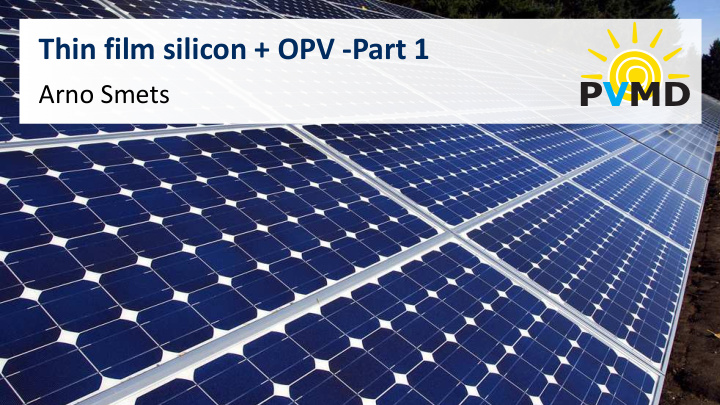



Thin film silicon + OPV -Part 1 Arno Smets PVMD Delft University of Technology
Learning objectives What are the design rules for a hybrid thin film silicon • and organic tandem device Use this concept to demonstrate the typical design • steps to make new device architectures
Record efficiencies OPV vs TF-Si 14 OPV: Thin Film Si PV: OPV: 12 11.8 % 16.3 % (United Solar) Single 11.3 % 14.8 % (TUDelft) 10 Double 11.3% 11.9 % (AIST) Efficiency (%) Triple 8 6 4 2 0 2000 2005 2010 2015 Alice Furlan, PhD thesis TU/e (2016)
Bandgap utilization 1,1 E G /q-0.8 V E G /q-0.6 V E G /q-1.2 V 1,0 0,9 V OC (V) 0,8 0,7 E G /q-1.0 V 0,6 0,5 1,2 1,4 1,6 1,8 2,0 2,2 E GAP (eV)
Material properties 1.0 1-j E g,opt V OC (V) J SC FF PCE (%) a-Si:H cells (mAcm - 0.8 3# 2 ) 2# PMDPP3T:PC 60 BM a-Si:H 1.73 0.98 12.7 75 9.3 1# 0.6 EQE 0.4 0.2 0.0 400 500 600 700 800 900 1000 Wavelength (nm)
Material properties 1.0 1-j E g,opt V OC (V) J SC FF PCE (%) a-Si:H cells (mAcm - 0.8 3# 2 ) 2# PMDPP3T:PC 60 BM a-Si:H 1.73 0.98 12.7 75 9.3 1# 0.6 EQE a-Si:H 1.68 0.95 13.8 74 9.7 0.4 0.2 0.0 400 500 600 700 800 900 1000 Wavelength (nm)
Material properties 1.0 1-j E g,opt V OC (V) J SC FF PCE (%) a-Si:H cells (mAcm - 0.8 3# 2 ) 2# PMDPP3T:PC 60 BM a-Si:H 1.73 0.98 12.7 75 9.3 1# 0.6 EQE a-Si:H 1.68 0.95 13.8 74 9.7 0.4 a-Si:H 1.60 0.89 16.2 73 10.4 0.2 0.0 400 500 600 700 800 900 1000 Wavelength (nm)
Material properties 1.0 1-j E g,opt V OC (V) J SC FF PCE (%) a-Si:H cells (mAcm - 0.8 3# 2 ) 2# PMDPP3T:PC 60 BM a-Si:H 1.73 0.98 12.7 75 9.3 1# 0.6 EQE a-Si:H 1.68 0.95 13.8 74 9.7 0.4 a-Si:H 1.60 0.89 16.2 73 10.4 0.2 PMDPP3T: 1.30 0.61 15.7 60 5.7 PC 60 BM 0.0 400 500 600 700 800 900 1000 Wavelength (nm)
Device structure LiF/Al/Ag PmDPP3T:PC 60 BM Ag/MoO 3 ZnO a-Si:H p-i-n ITO Glass H. Tan et al., Advanced Materials (2016) 9
Recommend
More recommend